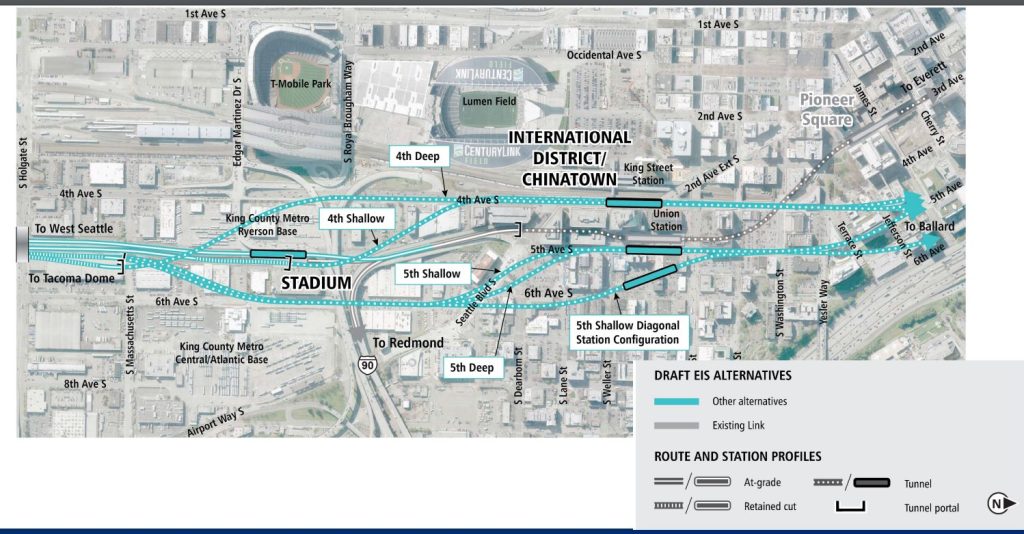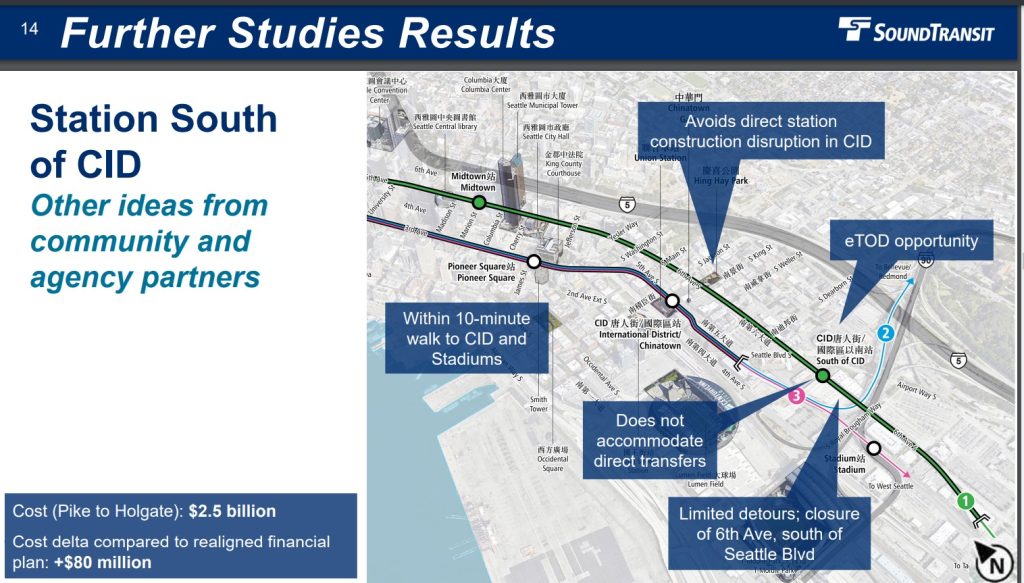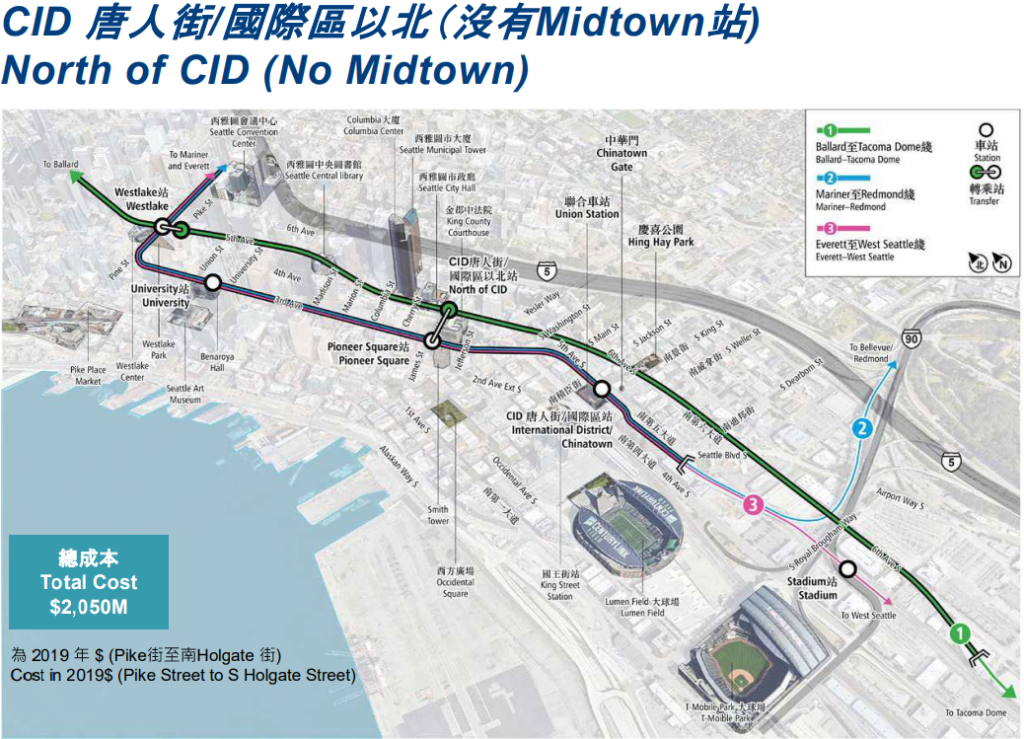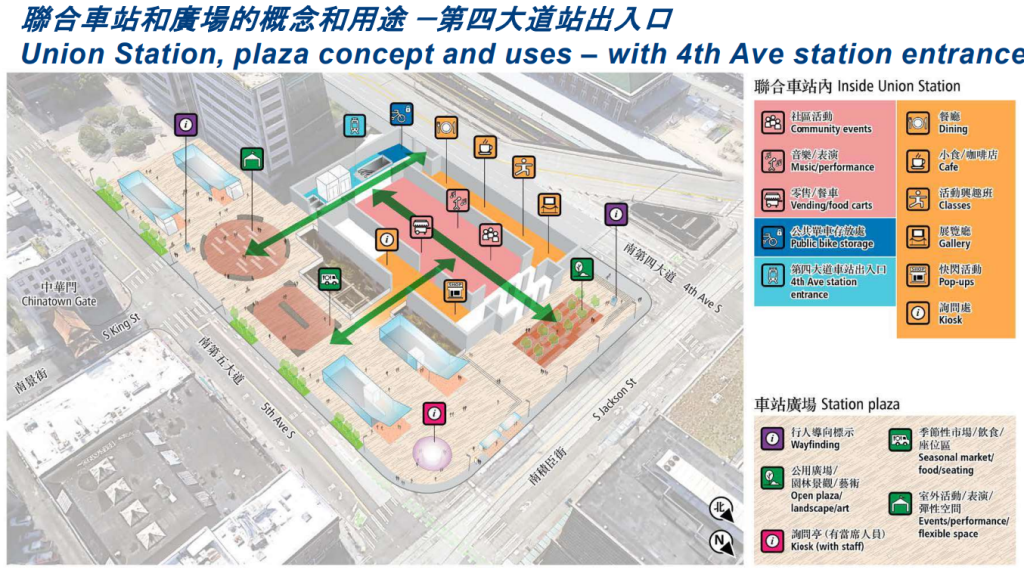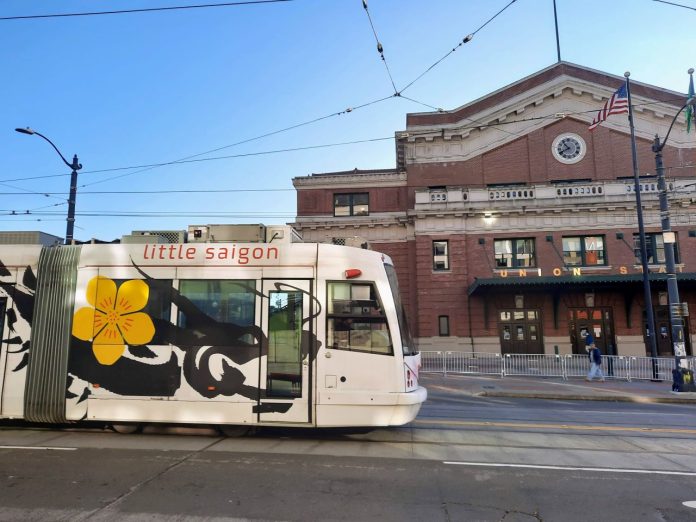
Will the station be shallow, deep, or somewhere between? On Fourth or Fifth Avenue? Or skip Chinatown and Midtown altogether for a Pioneer Square junction? Many ideas and questions are still swirling around how to build the second Chinatown-International District (CID) station that would form the crucial connective point for three light rail lines, the Seattle streetcar, Amtrak, Sounder commuter rail, and countless bus routes — or whether to build it at all.
The Urbanist has new renderings and diagrams to share, but frankly not a full grasp of what they really signify on the path to finally picking a preferred alternative and completing the environmental study that will clear the way to building the dang thing. Already, the Sound Transit Board has granted a six-month extension on the Chinatown alignment decision in hopes that greater outreach and study could help unify the neighborhood around an option. It doesn’t appear anything close to unanimity will be in the offing, and yet a decision must be made eventually all the same.
The board’s systems expansion committee will hear a “further studies results deeper dive” at its meeting on February 9 (see: earlier slides on the further studies for a foretaste). The full board is getting a community outreach summary on February 23. The system expansion committee is slated to send the agency’s recommendation to the board on March 9, culminating in a scheduled board vote on March 23 to set the preferred alternative for the Ballard Link Extension.
The agency has a further studies survey open through February 17.
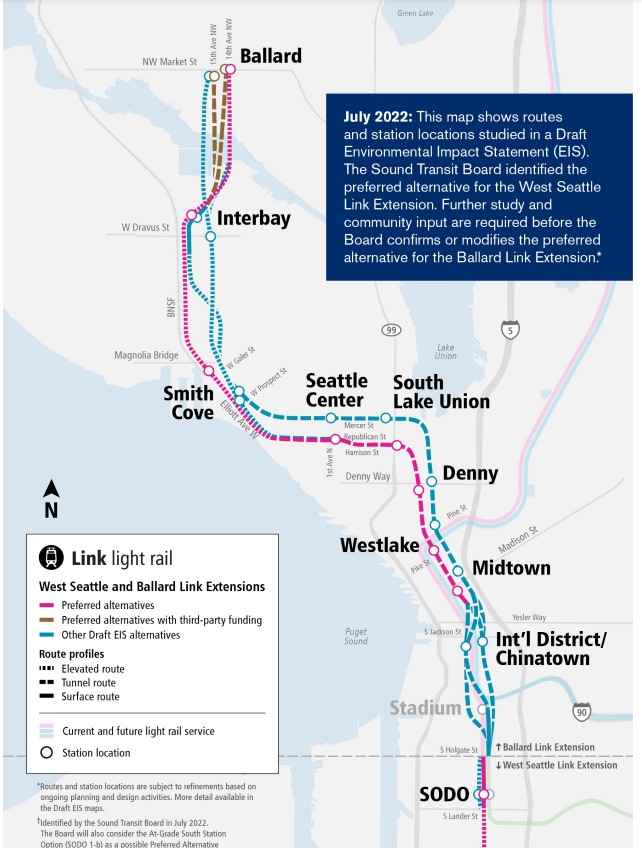
Sound Transit said all the information from the outreach meetings and public feedback will be passed along to its board of directors, who ultimately make the call. But how to digest that multitude of thought into a consensus alignment may not be straightforward or free of the need for political courage.
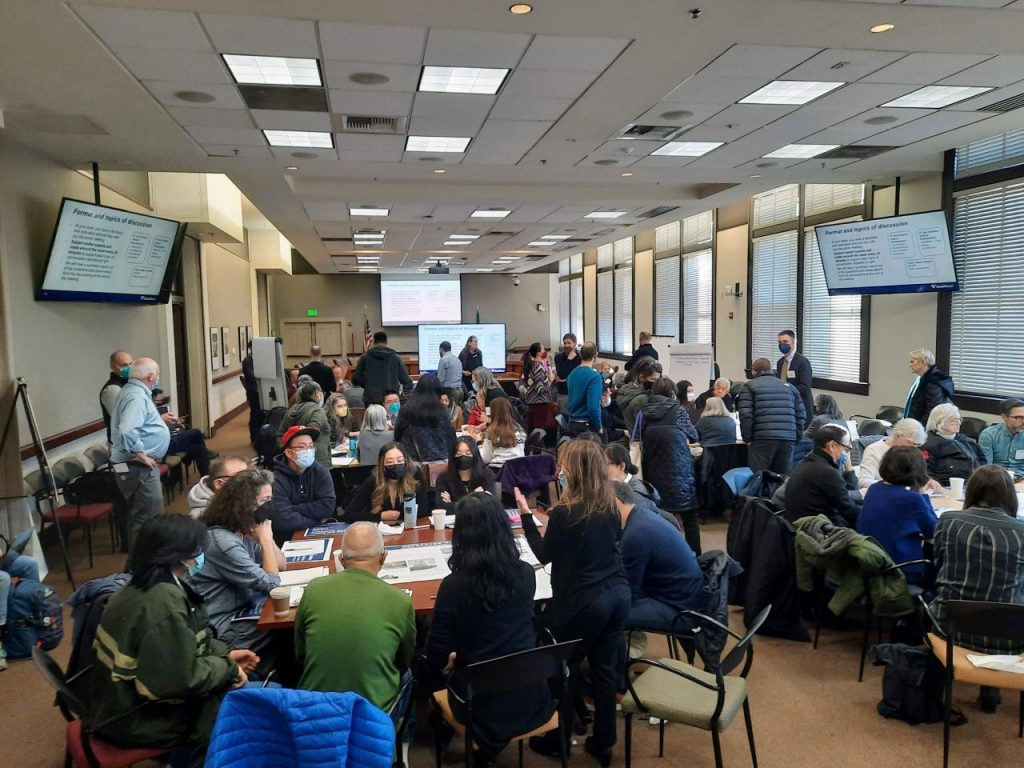
The closest thing to a consensus appears to be a shallow Fourth Avenue station. The majority of stakeholders (including the City of Seattle) don’t want a super deep station and don’t want it on Fifth Avenue where its construction would be more disruptive to businesses in Chinatown’s historic district. That leaves a shallow station on Fourth Avenue as an option. Instead of flitting to wildcard alternatives, the Sound Transit Board would be wise to focus on how to make a shallow 4th Station work really well.
How to pay for it, create excellent transfers and multimodal connections, and manage construction detours and mitigation all loom large as important questions to answer. And the longer the agency and its partners mull Hail Mary alternatives instead getting down to business of making the most sensible alternative work, the longer the process take while the chances of worse outcomes intensify.
South of CID Station
Some ideas are so bad they should be discarded outright. Putting a station up against the enormous I-90 freeway interchange south of CID makes no sense. The site has no direct transfers, very little walkability, and zero potential to grow a walkable urban neighborhood around it. It’s not a very workable idea. But since it fits within the realigned financial plan at $2.5 billion, this flawed alternative might get more attention than it deserves.
North of CID (No Midtown, No Good) Pioneer Square Station
Likewise, skipping Chinatown and Midtown doesn’t seem tenable either since it does not meet ST3’s promise to voters or usable service quality. There needs to be a south junction station where riders can make convenient transfers between transit lines. The new Westlake Station offers the north junction, but transfers might not be quick or pretty considering how deep it will be. The CID Station was the great hope for a south junction to have an excellent transfer point.
Skipping Chinatown and doing a “North of CID” station alternative leaves much to be desired. Such a station is too far from Sounder, Amtrak, and the streetcar. Sound Transit pegs the transfer at 12 minutes to Sounder or just over 3 minutes to transfer to the existing Pioneer Square Station to connect between light rail lines. The station would be about 103 feet deep for people headed to the surface. It’s not clear if there’d be separate elevators for those headed to make the light rail transfer.
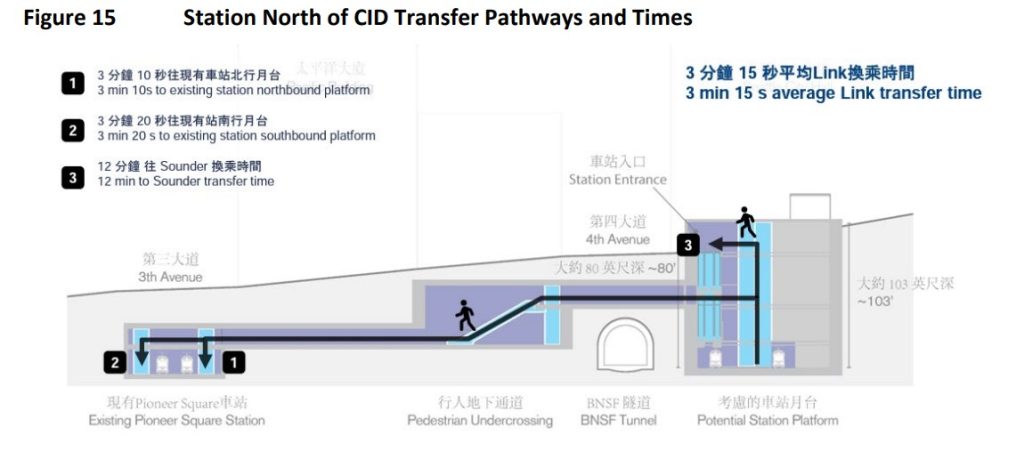
Dropping the Midtown Station would abandon First Hill, again, and greatly reduce the walkshed of the system overall. Few, if any, constituencies appear to actually support the idea of dropping the CID and Midtown Stations in favor of Pioneer Square, including Pioneer Square advocacy groups.
Nonetheless, the board might be tempted to entertain the idea since dropping an entire station would apparently save about $360 million over the realigned financial plan. It would come at the cost of service quality and promises to voters.
Refined 4th Shallow Station
During the Draft Environmental Impact Statement (Draft EIS) The Urbanist and Seattle Subway urged Sound Transit to study shallowest 4th Avenue possible that goes underneath the existing transit tunnel, and the agency has has done so.
Here’s where things get a little confusing. The “Refined 4th Ave Shallow” station in the further studies packet is not that “shallow(er)” station requested by advocates but a refined version of the one of the same depth of 80 feet. Because it goes underneath the existing transit tunnel, it would not allow a shallower Midtown Station — as confirmed in the engineering studies released by Sound Transit.
The Midtown Station will still need to be very deep (station depth is listed at “195-205 feet” in the graphic below) due to the need to go underneath the existing Downtown Seattle Transit Tunnel (DSTT) and other obstacles like building foundations, a Sound Transit spokesperson said. Note, 190 feet deep is the deepest station of the London Underground.
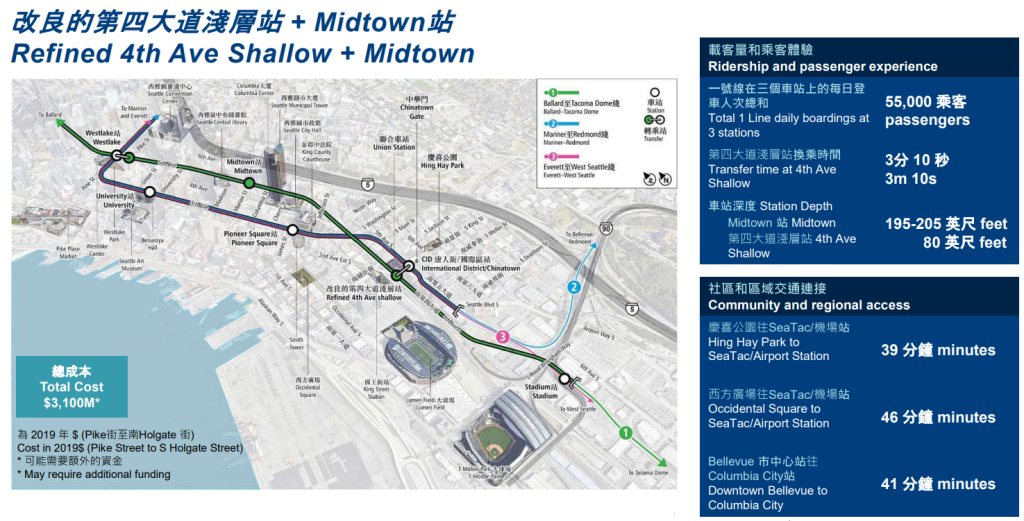
Even if Midtown would still need to be deep, a shallow 4th Avenue station does have the benefit of shorter times between the surface and the station platform. Sound Transit has pegged the downtown segment cost at $3.1 billion under the refined 4th Avenue shallow plus Midtown scenario and listed that as a plus “$700 million delta over the realigned financial plan.”
Shallower Station is better, but that info is a bit buried
A shallow(er) station — if constructable — would offer all those benefits and more. It’d be even quicker to the surface, and Sound Transit said it would pair with Midtown Station that is 50-65 feet less deep.
“The shallowest Midtown Station option in the further studies is about 140 to 145 feet deep and can be connected to the Refined 4th Shallow(er) station in CID,” Sound Transit spokesperson Rachelle Cunningham confirmed in an email.
While 140-feet-deep is hardly a “shallow” station, shaving off 50 feet (or more) is a big improvement. It should make escalators feasible to build, unlike the super deep options that were set to be elevator-only like 160-feet-deep Beacon Hill Station. That would provide redundancy and the times to the surface would be quicker for people disembarking trains. Not digging so deep should also be cheaper to build. Sound Transit said the shallower pairing would save big on Midtown Station costs, but the CID picture is more complicated.
“By going over the DSTT, the station depth can be reduced by approximately 35 feet,” an agency memo from January 24 notes. “This refinement would also increase the cost of the CID-1a in the CID Segment by approximately $300 million primarily due to additional properties affected by construction and staging, while at the same time it would decrease the cost in the Downtown Segment by approximately $200 million due to a shallower Midtown Station resulting in an overall increase of $100 million.”
The additional cost largely stems from needing to acquire more properties, many of them owned by King County. Those acquisitions could end up being great opportunities for equitable transit-oriented development and denser use. Among them is the vacated King County Administration Building and Macrae Parking Garage. The memo notes the shallower station and going over the DSTT would result in the following:
- The tunnel portal shifts to the north, extending the cut-and-cover construction by approximately 900 feet from S Main Street to just south of Jefferson Street. The extension of cut-and-cover would likely extend the full roadway closure of 4th Avenue S from Main Street to Terrace Street just north of Yesler Bridge.
- Reduces roadway closures at Midtown Station from full closure of 5th Avenue between Madison Street and Columbia Street to a partial closure of 5th Avenue between Marion Street and Columbia Street, for 18 months.
- Avoids reconstruction of the Main Street Bridge.
- Affects the Yesler Bridge foundations resulting in reconstruction of Yesler Bridge.
- Additional closures include Yesler Way for approximately two years, which would need to be staggered with S Jackson Street closure.
- Would fully close Washington Street at 4th Avenue for approximately two years affecting Seattle Fire Department access and circulation. This would also affect access from the west to the Seattle Office of Emergency Management located east of the fire department.
- Requires that four historic properties eligible for the National Register be demolished: the vacated King County Administration Building; 420 4th Avenue; Hotel Reynolds – a work release facility; and Macrae Parking Garage. In addition, two King County parcels that are assumed to support social services would be acquired.
- To minimize risk and to monitor the DSTT during construction, would likely require closure of the DSTT during non-revenue service hours, which could extend into regular service hours resulting in service disruptions.
- Additional constructability issues related to working near the century-old BNSF tunnel and added reconstruction of the BNSF retaining wall construction from S Main Street to the BNSF portal.
- Overall station construction duration would be similar to CID-1a station
Activating the station
One exciting thing to come out of the board-requested further study period is that Sound Transit has looked at station activation ideas. Those look very promising, with retail and amenities being envisioned within a reinvigorated Union Station hub alongside strong connections between the two light rail stations and potentially over to the Sounder and Amtrak station next door (the Union Station hub is another Urbanist promoted idea).
Sound Transit has also developed more ideas around how construction would go down should Fourth Avenue, which is major thoroughfare for buses and vehicle traffic, be torn up for extended periods during station construction. One concept would add a lid to the railyard on the west side of Fourth Avenue, but Sound Transit has deemed it impractical and likely to conflict with BNSF and Sounder rail operations.
“A traffic bearing lid is not practical because it would need to be higher than existing adjacent roadways to provide clearance to trains below,” Cunningham said in an email. “We are focusing on developing other strategies for mitigating potential traffic impacts.”
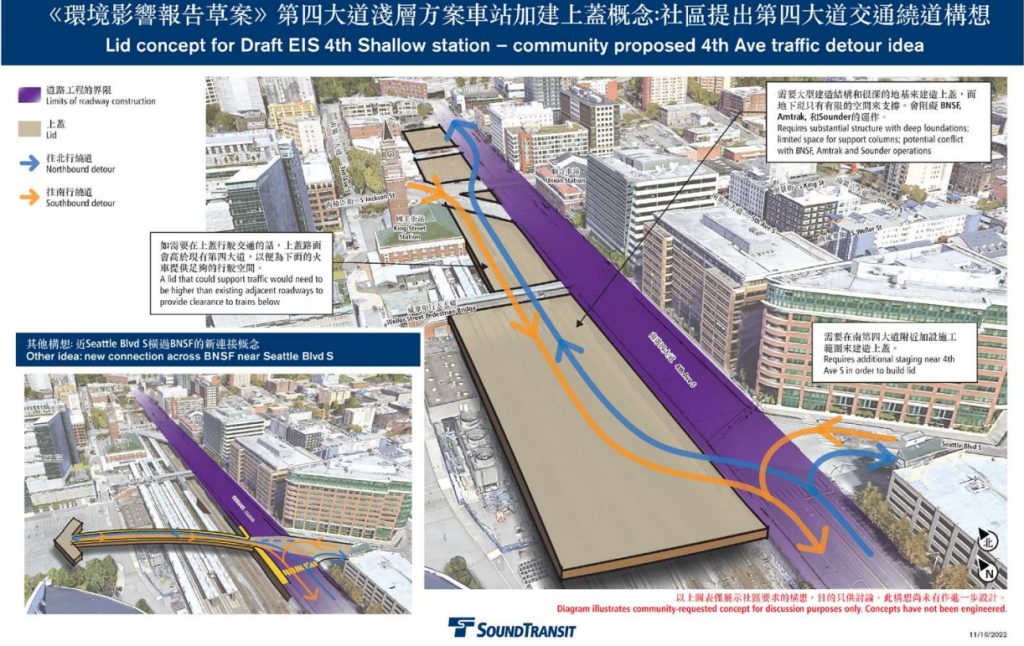
One of those other concepts is creating a new connection across the BNSF railyard at Seattle Boulevard. Utilizing the Lumen Field North Parking right-of-way, Seattle Boulevard could be extended to 2nd Avenue S, providing another detour route.
While it doesn’t look like a lid could support detours of motor vehicle traffic, Sound Transit has also floated the idea of putting park space, housing, or other forms of transit-oriented development atop the lid after Fourth Avenue reopens.
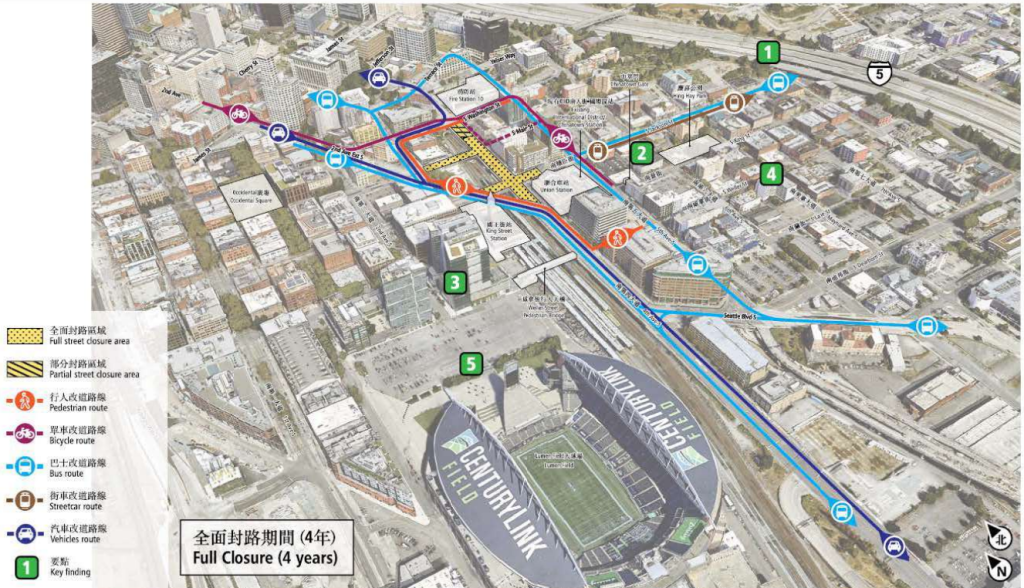
For all the necessary work, Fourth Avenue would be under construction for a decade, requiring a full closure of four years, the agency says. The sheer amount of buses — hundreds every day — using the Fourth Avenue corridor will make it essential to get the bus detours, priority, and timing correct. Otherwise transit agencies will burn their precious service hours having buses sit in gridlock, an all too frequent phenomenon in a region too shy about expanding bus lane and transit priority.
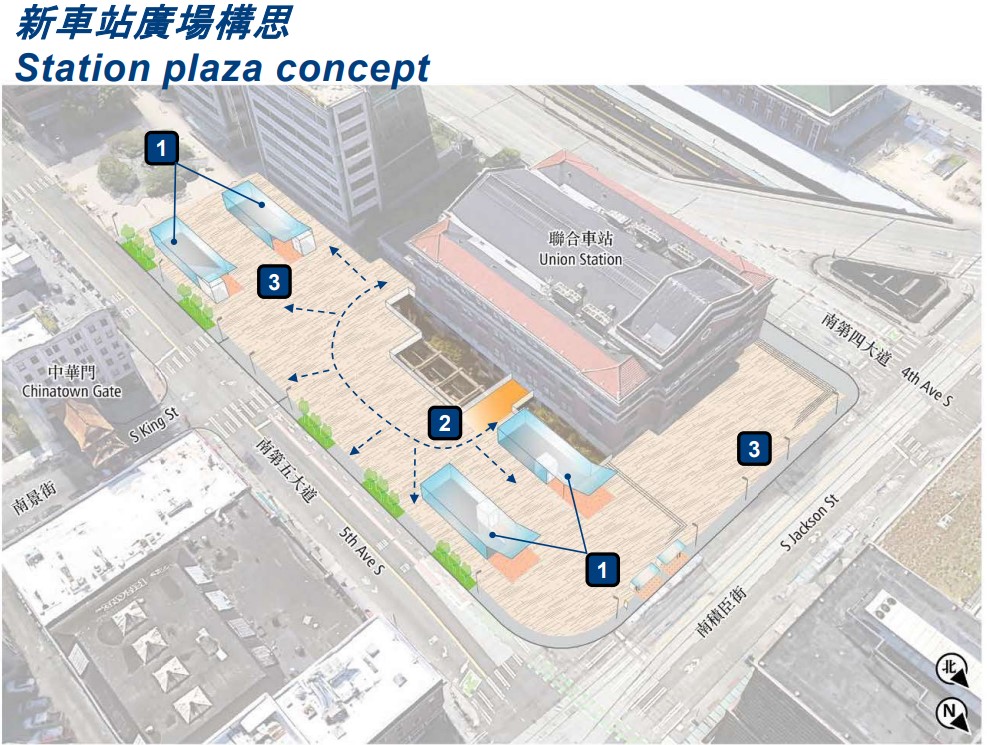
Community backlash and buy-in
The backlash and pushback coming from members of the Chinatown-International District community makes a ton of sense. Transportation departments and city hall have burned the neighborhood time and time again throughout its history. Plowing I-5 through, dividing and polluting the neighborhood is a prime example, as is siting the publicly-financed Kingdome next door over the objections of CID residents. In a few short decades, the Kingdome was demolished and replaced with two new stadiums for the Seattle Seahawks and Mariners, with the football stadium on the same site and the baseball field just to the south.
Some wounds are fresher. The First Hill Streetcar was disruptive to the neighborhood too, as it tore up Jackson Street for years, and that sacrifice was borne with the promise that the line would soon connect downtown and to Pike Place Market via the Center City Connector extension. Doing so would better serve local riders and draw in more customers for local businesses. However, that project was canceled by Mayor Jenny Durkan and restarted only half-heartedly. It currently sits in limbo with even a revised opening target of 2026, a full 10 years after the First Hill line opened, starting to look like a stretch unless the city acts quickly.
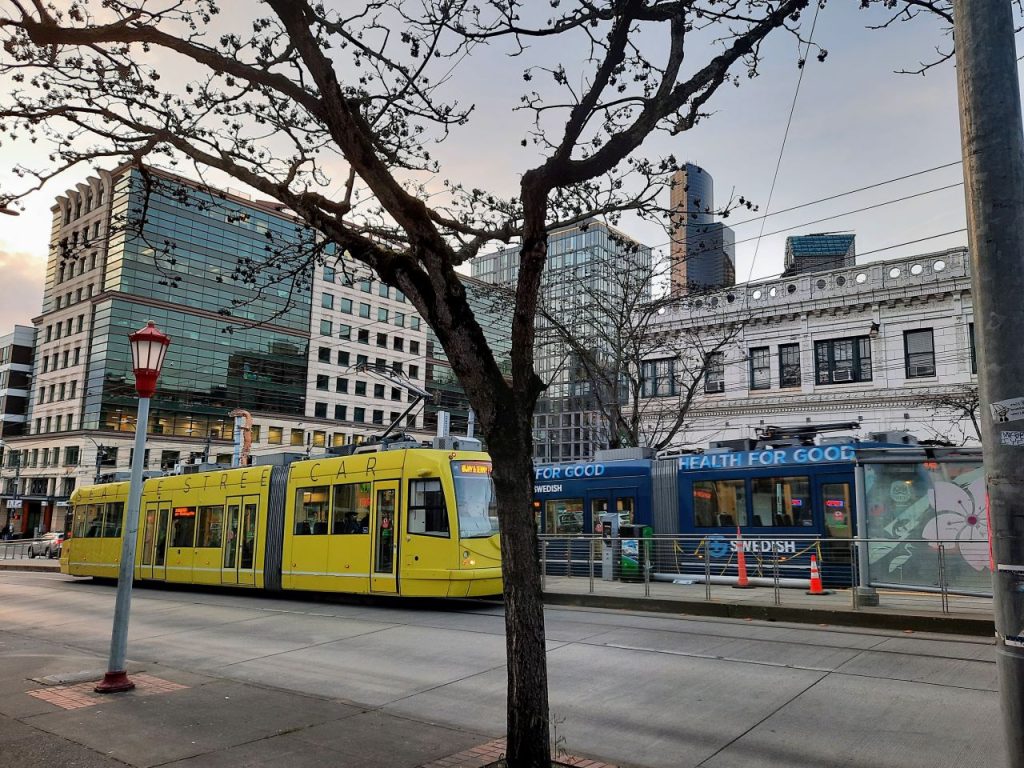
But instead of letting these lingering wounds be an excuse to not build another light rail station in the CID, Sound Transit and the City of Seattle must find a way to deliver an excellent project that begins rebuilding that trust. This starts by getting the construction mitigation right for businesses and residents alike and then delivering an excellent station with great connections, equitable transit-oriented development (TOD), and iconic art and placemaking led by the community.
The mitigation ideas need to be of a sufficient scale. Free ORCA transit passes for residents and workers dealing with headaches getting to and from the neighborhood during construction would be an easy place to start. City of Seattle could provide bus lanes and signal priority for buses interrupted by detours. Sound Transit must provide a small business mitigation funds and step in to ensure restaurants, shops, and galleries don’t go out of business due to construction impacts.
The City could stabilize commercial rents in the area (and look to do so elsewhere across the city) so that the opening of a new station does not lead to a spike in rents. (Unlike residential rent control or stabilization, commercial rent control is not banned by the state legislature.) Within the station area and potential TOD sites, the agency could provide small affordable storefronts that are perfect for the next wave of entrepreneurs striking out to launch culturally-significant businesses in the CID.
There’s incredible potential and opportunity when the conversation shifts from how to do a new CID Station well (and drag Sound Transit along on some of the ideas if we have to) rather than if we’re building it at all.
Take Sound Transit’s further studies survey, which is open through February 17. The agency is also hosting an open house at Union Station on February 8 from 3 to 7pm.
Update: This article was updated shortly after publication to include additional information about the Shallower 4th Option provided by Sound Transit, on February 6 to add the diagram illustrating Pioneer Square Station transfer, and on February 7th to note Sound Transit’s doubts the lid could support traffic and interest in a Seattle Boulevard extension.
Doug Trumm is publisher of The Urbanist. An Urbanist writer since 2015, he dreams of pedestrian streets, bus lanes, and a mass-timber building spree to end our housing crisis. He graduated from the Evans School of Public Policy and Governance at the University of Washington in 2019. He lives in Seattle's Fremont neighborhood and loves to explore the city by foot and by bike.


